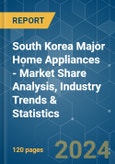The South Korea Major Home Appliances Market size is estimated at USD 9.18 billion in 2024, and is expected to reach USD 10.13 billion by 2029, growing at a CAGR of greater than 2% during the forecast period (2024-2029).
Major home appliances in South Korea are witnessing growth in the market due to constant innovation by the manufacturers. Samsung and LG are innovating new products such as refrigerators and washing machines with larger capacity for greater food storage. Product innovations and government policies are fostering the growth of IoT in the major appliances segment. The major home appliances market in South Korea is driven by increasing single families, premiumization of products, personalization, and cost reduction by automation in the home appliances market. Fine articulation, on the other hand, has been an issue in the major home appliances market for some of the consumers seeking a healthy lifestyle. Advancements in Technologies and speed of development are supporting the growth of the South Korean major home appliances market. Smart Home appliances have become a vital part of the home appliances market in South Korea.
The COVID-19 pandemic led to a change in South Korea's major home appliance consumption trends; the popularity of electronics helping with household chores increased as most of the population worked from home, and spending more time at home required many appliances that could complete tasks quickly.
Dishwashers are emerging as must-haves for households in South Korea's market. The popularity of dishwashers has been rising among different age groups in the market. Different age groups are more and more interested in having dishwashers in the country as they help people in washing dishes by saving time.
This product will be delivered within 2 business days.
Major home appliances in South Korea are witnessing growth in the market due to constant innovation by the manufacturers. Samsung and LG are innovating new products such as refrigerators and washing machines with larger capacity for greater food storage. Product innovations and government policies are fostering the growth of IoT in the major appliances segment. The major home appliances market in South Korea is driven by increasing single families, premiumization of products, personalization, and cost reduction by automation in the home appliances market. Fine articulation, on the other hand, has been an issue in the major home appliances market for some of the consumers seeking a healthy lifestyle. Advancements in Technologies and speed of development are supporting the growth of the South Korean major home appliances market. Smart Home appliances have become a vital part of the home appliances market in South Korea.
The COVID-19 pandemic led to a change in South Korea's major home appliance consumption trends; the popularity of electronics helping with household chores increased as most of the population worked from home, and spending more time at home required many appliances that could complete tasks quickly.
South Korea Major Home Appliances Market Trends
Washing Machines are Highly Demanded Major Appliances in South Korea
Koreans' demand for washing machines is constantly rising, with front-load washing machines gaining more share in the market. Top-load washing machines are losing share to front-load machines due to their more powerful function and use in the commercial sector. On the other hand, automatic dryers are also gaining popularity. South Koreans are also preferring washing machines with IoT and are looking for premium segment washing machines.Rising Popularity of Dishwashers Among South Koreans
Dishwashers are drawing attention as the household appliance that decreases household labor for South Koreans. There is an upward trend in buying dishwashers in the South Korean large home appliance market. Millennials and working couples in the country are demanding dishwashers to seek convenience.Dishwashers are emerging as must-haves for households in South Korea's market. The popularity of dishwashers has been rising among different age groups in the market. Different age groups are more and more interested in having dishwashers in the country as they help people in washing dishes by saving time.
South Korea Major Home Appliances Industry Overview
The major home appliances market in South Korea is competitive with the presence of local manufacturers and global manufacturers. There is a rise in competition in the country because of the presence of Japanese and Chinese players. The manufacturer, therefore, is producing products in the overseas market to cater to demand in the premium category. Key companies in the market include LG Electronics Inc., Samsung Electronics, Electrolux AB, Whirlpool Corporation, and Bosch, among others.Additional Benefits:
- The market estimate (ME) sheet in Excel format
- 3 months of analyst support
This product will be delivered within 2 business days.
Table of Contents
1 INTRODUCTION
4 MARKET INSIGHTS AND DYNAMICS
5 MARKET SEGMENTATION
6 COMPETITIVE LANDSCAPE
Companies Mentioned (Partial List)
A selection of companies mentioned in this report includes, but is not limited to:
- LG Electronics
- Dong Yang Diecasting Co.
- Samsung Electronics
- Bosch
- Electrolux AB
- Whirlpool Corporation
- Panasonic Corporation
- Haier Electronics Group Co. Ltd
- Mitsubishi Electric Corporation
- Gorenje Group*
Methodology

LOADING...










